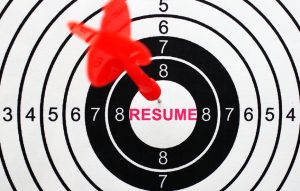Join our online community and be inspired to achieve your goals!
VIEW OUR FACEBOOK PAGE7 tips to tailor your resume
Have you been applying for new roles and not getting much response? If you do not tailor your resume to specifically suit the role, you could be limiting your chances. In a competitive job market, you need all the advantages you can get – so sending out a stock standard document probably won’t achieve the results you’re after. But where do you start, and what information should you tailor?
In my role as a Resume Writer, I have personally reviewed and advised more than 1,000 clients on their Resumes. Many of them aren’t great – after all, clients come to us for assistance and advice because they recognise their current approach is not working. That said, one of the primary mistakes I see is relevance of the content.
Many clients want to ensure they ‘cover all the bases’ and provide a resume that talks to many different roles. This is never our recommended approach for several reasons. You just can’t be all things to all people. Also, today more than ever before, the importance of specialisation cannot be underestimated because almost everybody is ‘multi-skilled’. Tailoring your Resume to specifically suit the role you are applying for helps you to highlight your specialist skills, and the unique reasons why you could excel in the role.
Your content should ideally fit a maximum of three to four pages and every word needs to count in convincing the recruiter you deserve an interview. It is much harder to write less than more – short, sharp succinct content takes time and effort but will achieve better results in the end. So where do you start, and what information can be tailored?
TIP # 1 – Research: the first step is to research the job ad carefully and identify exactly what the recruiter is looking for. Highlight the skills or experience that seem important and make notes. If the company is advertising directly, have a look at their website, and do a Google search for the company name to find out if any current company or industry events might impact the job. Writing just one sentence that references your knowledge of a current situation could mean the difference between success and failure at this initial stage.
TIP # 2 – Career Profile: we always recommend including a customised career profile in your Resume. The profile should introduce you and highlight what you bring to the role. It should briefly demonstrate your skills, experience, and successes, while highlighting how they add value. Most people see this section as fairly standard; however by customising the content to address individual job requirements, or even using the same language as the recruiter – you will put yourself a step ahead. Make it enthusiastic, passionate, easy to understand, concise and engaging – and clearly demonstrate ‘what’s in it for the employer’.
KTIP # 3 – Key Capabilities: once you know the recruiter’s priorities in terms of what they’re looking for, you can also customise your ‘key skills or capabilities list’. In its simplest form, this means re-ordering your list. Get more involved by rewording those key points and/or customising them to suit the job requirements. Think about what the role needs and demonstrate how you can provide it through some past experience, success, training, or education.
TIP # 4 – Job History: over time, some content may become less relevant to the roles you are applying for today, or perhaps the content is simply dated. It is a good idea to reduce the detail listed under older roles whenever you add recent content. Your Resume needs to convey the most important information about you and your past experience to get you in the door but without becoming too lengthy.
TIP # 5 – Order of Previous Roles: this is not something we recommend doing unless absolutely necessary because the Resume can become confusing if not done well. However, where we may recommend doing this is if you have highly relevant experience in your past work history, with the recent roles not at all relevant. In this case, you should make a new section called ‘Relevant Employment History’ then list the relevant roles. Move your other more recent role descriptions to a section called ‘Other Employment History’. This means that the recruiter will see your ‘relevant experience’ first but the title of the section will give some insight into why that experience is not recent.
TIP # 6 – Achievements: our research indicates that recruiters look for achievements while more quickly discarding resumes that are purely ‘responsibilities’ focused. Try to highlight at least two or three achievements for each role – but tailor them to support your ability to perform in the role you are applying for. Tangible achievements should be first priority, but you can also think about projects you’ve contributed to, collaboration with colleagues, extra responsibilities taken on, new processes you initiated, customer accolades received or major targets exceeded. Think about any aspect where you went above and beyond – chances are, recruiters will consider these achievements.
TIP # 7 – Referees: while it isn’t necessary to include names and contact details (unless specifically requested), or copies of written references, you should do so if the referee is highly relevant to the role you are applying for. An industry expert or well respected leader will certainly add value and credibility to your application.
A well written, tailored Resume won’t get you the job – that’s up to you to achieve at the interview. However, it will help you secure the all-important interview. If you follow these tips, you’ll be able to quickly and easily customise your Resume to help recruiters make that all important decision about whether or not that happens.
Would you benefit from some assistance identifying and articulating the most important information to include in your Resume so your next job application has a better chance of standing out? If so, please see our Resume Writing Services.


